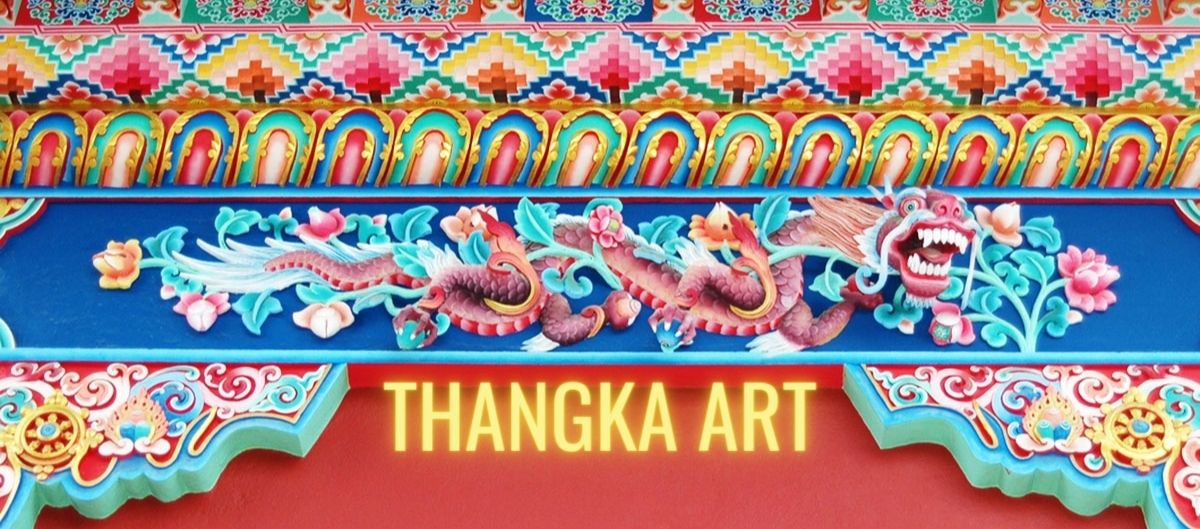The Ultimate Recorded Message of Thangka Art

It’s an 11th century Buddhist VM! Thangka roughly translates to “recorded message” in Tibetan and is an ancient form of Buddhist art.
The art of India and Nepal is one of flamboyance! Color in capitals! Flags fly, ropes of marigolds are offered to visitors along with welcoming red bindis and bracelets. Each with a prayer. Carvings, sculptures, paintings…all celebratory and strange. But so beautiful!


I watched artists in the city of Patan, near Kathmandu Nepal, practice the painstaking but gorgeous art of Thangka.


More than simply paint on paper, it is practiced as a religion, originally performed by lamas or Buddhist priests. The process is infinitely precise.

The designs are specific. Thangkas can depict deities, a mandala (a geometric figure with symbolic meaning used as an aid in meditation) or a spiritually significant event in the life of a Buddhist master.


A long and tedious process, often taking months to complete, the designs are pencilled in according to perfect measurements, then painted in detail sometimes requiring brushes no wider than a single hair to complete. The guidelines are strict. Form, color, position, stance, mood…all must comply.
Thangka are typically painted on cotton or silk, are square or rectangular, accented with gold and rolled when not on display. I was fortunate to be able to purchase a kalachakra mandala painted in the Thangka style.

In ancient Sanskrit of Hinduism and Buddhism mandala means “circle.”
Traditionally, a mandala is a geometric design or pattern that represents the cosmos or deities in various heavenly worlds.
Wikipedia
The Kalachakra Mandala can be expressed in many mediums, on canvas or in a temporary environment such as the complex colored sand patterns created by Tibetan monks.

It represents a large building or palace standing on a raised foundation with four walls and a door in the center of each. A roof encompasses the structure.
Within their intricate circular patterns, you can find common symbols throughout mandalas. Traditionally, they include the presence of Buddha’s mind in an abstract form, most commonly represented as a wheel, tree, flower, or jewel. The center is a dot, which is a symbol considered free of dimensions. It is interpreted as the starting point, the beginning of contemplation, and devotion to the divine. From there, the dot is surrounded by lines and geometrical patterns that symbolize the universe, encompassed by the outer circle which represents the cyclical nature of life.
invaluable.com
Staring at a mandala is calming. Its precision, repetition of symbols, brilliant colors and symmetry represents the thought that everything in our lives is in harmony. Or could be.
Related Posts
Rio de Janeiro and the Girl from Ipanema: Where Music Meets the Sea
Rio de Janeiro is more than a city—it’s sun-soaked poetry. From the iconic Christ the …
May 3, 2025Visit the Most Beautiful Bookstore in the World
It’s called El Ateneo, Spanish for “The Athenaeum”, a place associated with learning, the arts …
April 26, 2025

Bikash | 31st Dec 24
This is such an exciting and fascinating post! The intricate art of Thangka painting is not only a testament to the precision and dedication of its artists, but also a deep spiritual practice tied to the rich Buddhist traditions of Nepal. The connection to the Everest region is particularly striking, as the spirituality of the Himalayas and its surrounding cultures infuse Thangka art with even more profound meaning.